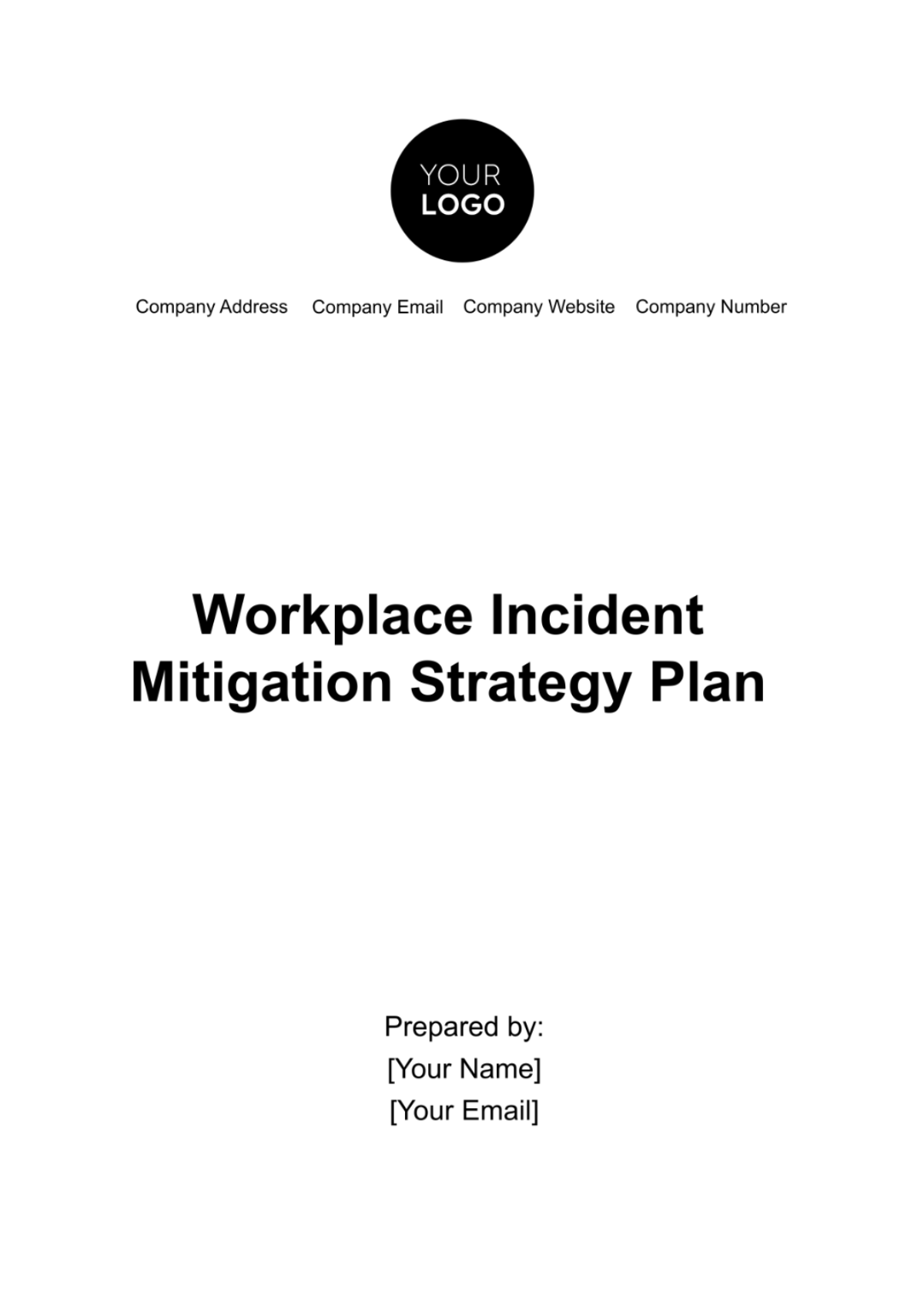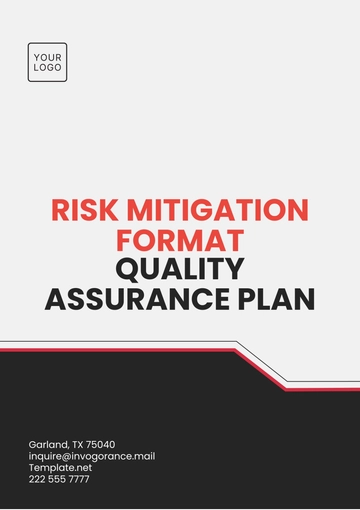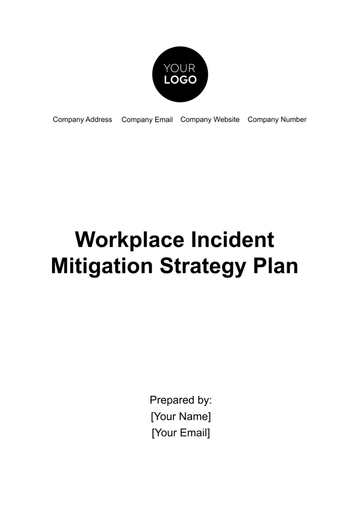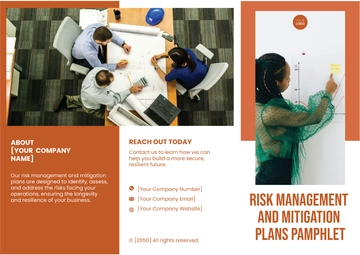Free Workplace Incident Mitigation Strategy Plan

1. Executive Summary
The Workplace Incident Mitigation Strategy Plan is a testament to our unwavering commitment to the safety and well-being of our employees, in full accordance with US health and safety standards. Our overarching objective is to achieve a 15% reduction in workplace incidents over the next year while maintaining strict compliance with all applicable legal regulations, including the Occupational Safety and Health Act (OSHA) and Environmental Protection Agency (EPA) standards.
2. Introduction
Workplace safety is the cornerstone of our organization's values, reflecting our unwavering commitment to safeguarding the health and well-being of our employees. Recognizing that our most valuable assets are our workforce, we prioritize creating a secure and nurturing environment where everyone can thrive without the fear of workplace incidents or accidents.
The purpose of this Workplace Incident Mitigation Strategy Plan is to outline our comprehensive approach to minimizing workplace incidents, aligning rigorously with US health and safety standards. It serves as our roadmap to prevent accidents, reduce risks, and ensure strict compliance with legal regulations, including the Occupational Safety and Health Act (OSHA) and Environmental Protection Agency (EPA) standards. By fostering a culture of safety and continuous improvement, we aspire to create a workplace where safety is not just a priority but a way of life.
3. Legal and Regulatory Framework
Our Workplace Incident Mitigation Strategy Plan is underpinned by rigorous compliance with a range of US laws, regulations, and standards that are vital for ensuring workplace safety. These regulations include:
a. Occupational Safety and Health Act (OSHA):
We adhere to OSHA requirements, which mandate the provision of a safe and healthful working environment. This includes compliance with OSHA standards for hazard communication, machine guarding, respiratory protection, and more.
b. Environmental Protection Agency (EPA) Standards:
Our organization maintains strict adherence to EPA standards governing hazardous waste management and chemical safety. We are committed to the responsible handling and disposal of hazardous materials, in line with EPA regulations.
c. National Fire Protection Association (NFPA) Guidelines:
We comply with NFPA guidelines to ensure effective fire prevention and protection. This includes fire safety measures, emergency response planning, and proper storage of flammable materials, as outlined by NFPA standards.
4. Risk Assessment
Our commitment to workplace safety begins with a comprehensive and systematic assessment of potential hazards and risks. This section is designed to:
a. Hazard Identification:
Our team diligently identifies workplace hazards, including but not limited to:
Chemical Exposures: We assess the presence of hazardous chemicals and their potential impact on employee health.
Physical Hazards: This includes dangers such as machinery, electrical systems, and fall risks.
Ergonomic Risks: We evaluate ergonomic factors to prevent musculoskeletal disorders.
Biological Hazards: We identify biological agents that may pose health risks, such as pathogens.
b. Risk Assessment Methods:
Our risk assessment employs a combination of proven methods, including:
Job Hazard Analysis (JHA): A systematic examination of each job to identify potential hazards.
Safety Audits and Inspections: Regular inspections of the workplace to uncover hidden risks.
Incident Data Analysis: Analysis of historical incident data to identify patterns and emerging risks.
c. Prioritization of Risks:
Once hazards are identified and assessed, we prioritize them based on severity and likelihood of occurrence. This risk ranking helps us allocate resources effectively to mitigate the most critical risks promptly.
5. Mitigation Strategies
In this section, we outline our multifaceted approach to mitigating workplace incidents. We employ various strategies and actions that encompass engineering controls, administrative controls, personal protective equipment (PPE), training and education, and emergency response procedures. These measures are essential to ensuring a safe working environment in full compliance with US health and safety standards.
Strategy | Description |
Engineering Controls |
|
Administrative Controls |
|
Personal Protective Equipment (PPE) |
|
Training and Education |
|
Emergency Response Procedures |
|
6. Incident Reporting and Investigation
Our organization maintains a systematic and thorough approach to incident reporting, documentation, and investigation to ensure compliance with legal requirements and promote a culture of safety. The procedures are as follows:

Throughout this procedure, strict compliance with all legal requirements, including OSHA regulations, is maintained to promote a culture of safety and continuous improvement.
7. Training and Awareness
We prioritize employee safety through comprehensive training programs and ongoing awareness campaigns designed to instill best practices and foster a culture of safety:
Onboarding Safety Training: All new employees receive rigorous safety training as part of their onboarding process, covering essential safety protocols, hazard recognition, and emergency procedures.
Regular Safety Training: Ongoing training sessions are conducted for all employees to reinforce safety knowledge and skills. Topics include proper equipment use, safe work practices, and hazard communication.
Safety Awareness Campaigns: We run continuous safety awareness campaigns, including monthly safety newsletters, posters, and toolbox talks, to keep safety at the forefront of employees' minds.
Specialized Training: Employees in high-risk roles receive specialized training, such as first aid and CPR, forklift operation, and confined space entry, ensuring competence in critical areas.
Emergency Response Drills: Regular emergency response drills, including fire drills and evacuation exercises, prepare employees to respond effectively in crises.
8. Emergency Response and Evacuation Plan
Our Emergency Response and Evacuation Plan ensures a swift and organized response to various emergencies while prioritizing the safety of all employees. The plan includes:
a. Fire Emergencies
Immediate activation of fire alarm systems.
Safe evacuation following posted evacuation routes.
Designated assembly points for headcounts.
Fire extinguisher use by trained personnel only.
Calling 911 and alerting authorities.
b. Chemical Spills
Isolation of the affected area.
Alerting coworkers to evacuate if necessary.
Contacting our hazmat team for containment and cleanup.
Decontamination procedures for affected individuals.
c. Medical Emergencies
Promptly calling 911 for medical assistance.
Administering first aid by trained personnel.
Notifying supervisors and coworkers.
Evacuating the immediate area if required.
d.. Evacuations
Well-marked evacuation routes posted throughout the facility.
Designated assembly points away from the building.
Accountability checks to ensure all employees are safe.
Evacuation coordinators to guide the process.
Communication protocols for emergency updates.
9. Monitoring and Evaluation
Our commitment to safety extends to continuous monitoring and evaluation of the Workplace Incident Mitigation Strategy Plan to ensure its effectiveness over time. This process includes regular safety inspections and audits conducted by trained personnel. These inspections encompass comprehensive assessments of workplace conditions, hazard identification, and compliance with safety protocols.
Additionally, incident analysis forms a crucial component of our evaluation process. We analyze all workplace incidents and near-misses to identify trends, root causes, and areas for improvement. Lessons learned are integrated into our strategies, promoting a culture of continuous improvement in line with US health and safety standards.
10. Communication and Documentation
Effective communication and meticulous documentation are fundamental to our commitment to workplace safety. We employ various methods to ensure that information regarding safety reaches employees and stakeholders:
Regular Safety Meetings: We conduct regular safety meetings with employees to discuss safety topics, share updates, and address concerns.
Safety Training: Comprehensive safety training programs include hazard communication and safety procedures, ensuring that employees are well-informed.
Safety Posters and Notices: We display safety posters and notices in prominent locations throughout the workplace to reinforce safety messages.
Safety Newsletters: Monthly safety newsletters provide updates on safety initiatives, incident summaries, and reminders of safety best practices.
Incident Reporting System: A user-friendly incident reporting system is in place, encouraging employees to report incidents and near-misses promptly.
Documented Safety Activities: All safety-related activities, including incident reports, investigations, training records, and corrective actions, are meticulously documented for compliance and improvement purposes.
11. Continuous Improvement
We are unwavering in our commitment to continuous improvement in workplace safety. Our approach includes regular reviews and updates to the Workplace Incident Mitigation Strategy Plan. We proactively analyze incident trends, near-misses, and lessons learned from incidents to identify areas for enhancement.
Furthermore, we stay vigilant in monitoring changing regulations, ensuring that our plan remains aligned with evolving US health and safety standards. By prioritizing ongoing improvement, we demonstrate our dedication to creating a safer work environment, protecting our employees, and consistently meeting or exceeding compliance requirements.
- 100% Customizable, free editor
- Access 1 Million+ Templates, photo’s & graphics
- Download or share as a template
- Click and replace photos, graphics, text, backgrounds
- Resize, crop, AI write & more
- Access advanced editor
You may also like
- Finance Plan
- Construction Plan
- Sales Plan
- Development Plan
- Career Plan
- Budget Plan
- HR Plan
- Education Plan
- Transition Plan
- Work Plan
- Training Plan
- Communication Plan
- Operation Plan
- Health And Safety Plan
- Strategy Plan
- Professional Development Plan
- Advertising Plan
- Risk Management Plan
- Restaurant Plan
- School Plan
- Nursing Home Patient Care Plan
- Nursing Care Plan
- Plan Event
- Startup Plan
- Social Media Plan
- Staffing Plan
- Annual Plan
- Content Plan
- Payment Plan
- Implementation Plan
- Hotel Plan
- Workout Plan
- Accounting Plan
- Campaign Plan
- Essay Plan
- 30 60 90 Day Plan
- Research Plan
- Recruitment Plan
- 90 Day Plan
- Quarterly Plan
- Emergency Plan
- 5 Year Plan
- Gym Plan
- Personal Plan
- IT and Software Plan
- Treatment Plan
- Real Estate Plan
- Law Firm Plan
- Healthcare Plan
- Improvement Plan
- Media Plan
- 5 Year Business Plan
- Learning Plan
- Marketing Campaign Plan
- Travel Agency Plan
- Cleaning Services Plan
- Interior Design Plan
- Performance Plan
- PR Plan
- Birth Plan
- Life Plan
- SEO Plan
- Disaster Recovery Plan
- Continuity Plan
- Launch Plan
- Legal Plan
- Behavior Plan
- Performance Improvement Plan
- Salon Plan
- Security Plan
- Security Management Plan
- Employee Development Plan
- Quality Plan
- Service Improvement Plan
- Growth Plan
- Incident Response Plan
- Basketball Plan
- Emergency Action Plan
- Product Launch Plan
- Spa Plan
- Employee Training Plan
- Data Analysis Plan
- Employee Action Plan
- Territory Plan
- Audit Plan
- Classroom Plan
- Activity Plan
- Parenting Plan
- Care Plan
- Project Execution Plan
- Exercise Plan
- Internship Plan
- Software Development Plan
- Continuous Improvement Plan
- Leave Plan
- 90 Day Sales Plan
- Advertising Agency Plan
- Employee Transition Plan
- Smart Action Plan
- Workplace Safety Plan
- Behavior Change Plan
- Contingency Plan
- Continuity of Operations Plan
- Health Plan
- Quality Control Plan
- Self Plan
- Sports Development Plan
- Change Management Plan
- Ecommerce Plan
- Personal Financial Plan
- Process Improvement Plan
- 30-60-90 Day Sales Plan
- Crisis Management Plan
- Engagement Plan
- Execution Plan
- Pandemic Plan
- Quality Assurance Plan
- Service Continuity Plan
- Agile Project Plan
- Fundraising Plan
- Job Transition Plan
- Asset Maintenance Plan
- Maintenance Plan
- Software Test Plan
- Staff Training and Development Plan
- 3 Year Plan
- Brand Activation Plan
- Release Plan
- Resource Plan
- Risk Mitigation Plan
- Teacher Plan
- 30 60 90 Day Plan for New Manager
- Food Safety Plan
- Food Truck Plan
- Hiring Plan
- Quality Management Plan
- Wellness Plan
- Behavior Intervention Plan
- Bonus Plan
- Investment Plan
- Maternity Leave Plan
- Pandemic Response Plan
- Succession Planning
- Coaching Plan
- Configuration Management Plan
- Remote Work Plan
- Self Care Plan
- Teaching Plan
- 100-Day Plan
- HACCP Plan
- Student Plan
- Sustainability Plan
- 30 60 90 Day Plan for Interview
- Access Plan
- Site Specific Safety Plan


